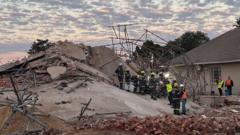A recent report indicates that the building collapse in South Africa that resulted in the death of 34 workers was preventable, highlighting serious structural issues and safety concerns raised beforehand. Calls for reform and accountability emerge as survivors continue to cope with the aftermath.
South Africa's Building Collapse: A Tragedy That Could Have Been Averted

South Africa's Building Collapse: A Tragedy That Could Have Been Averted
Report reveals preventable factors behind the deadly construction disaster in George, sparking calls for accountability and reform.
A devastating building collapse that killed 34 workers and injured many more in George, Western Cape, last May has been deemed "entirely preventable" by South African authorities. A newly disclosed report underscores a series of alarming safety concerns that were raised prior to the incident involving a partially-constructed five-storey apartment building.
Public Works Minister Dean Macpherson, who expressed his outrage over the findings, stated that multiple failures were responsible for the disaster, including the use of inferior materials and the existence of noticeable structural defects. "There were a number of red flags that were continually raised about this project," Macpherson remarked. Evidence suggests that some building deficiencies had been identified a year before the collapse occurred, yet construction continued despite the warnings.
The report reveals a troubling culture of negligence, as the appointed health and safety officer resigned in protest, yet work persisted, ignoring critical safety signals. Workers had reported feeling unsettling vibrations in the structure, and were instructed to fill the holes with sand and below-standard concrete instead of addressing the fundamental issues.
Described as both "emotional and painful," Macpherson's private meetings with survivors and victims' families have intensified demands for accountability against those deemed responsible for the disaster. A police investigation is currently in progress, although no arrests have been made thus far.
Survivors remain in dire conditions, battling trauma, medical expenses, and financial instability. One survivor, Elelwani, recounted the harsh changes in her life since the incident, revealing serious health impacts and social challenges she now faces as she appeals for help.
In response to the report, Macpherson has committed to introducing new regulations aimed at enhancing construction oversight, pledging to reform outdated legal frameworks surrounding building practices. The investigation was conducted by the Council for the Built Environment alongside the Engineering Council of South Africa, seeking to prevent future tragedies of this nature.




















